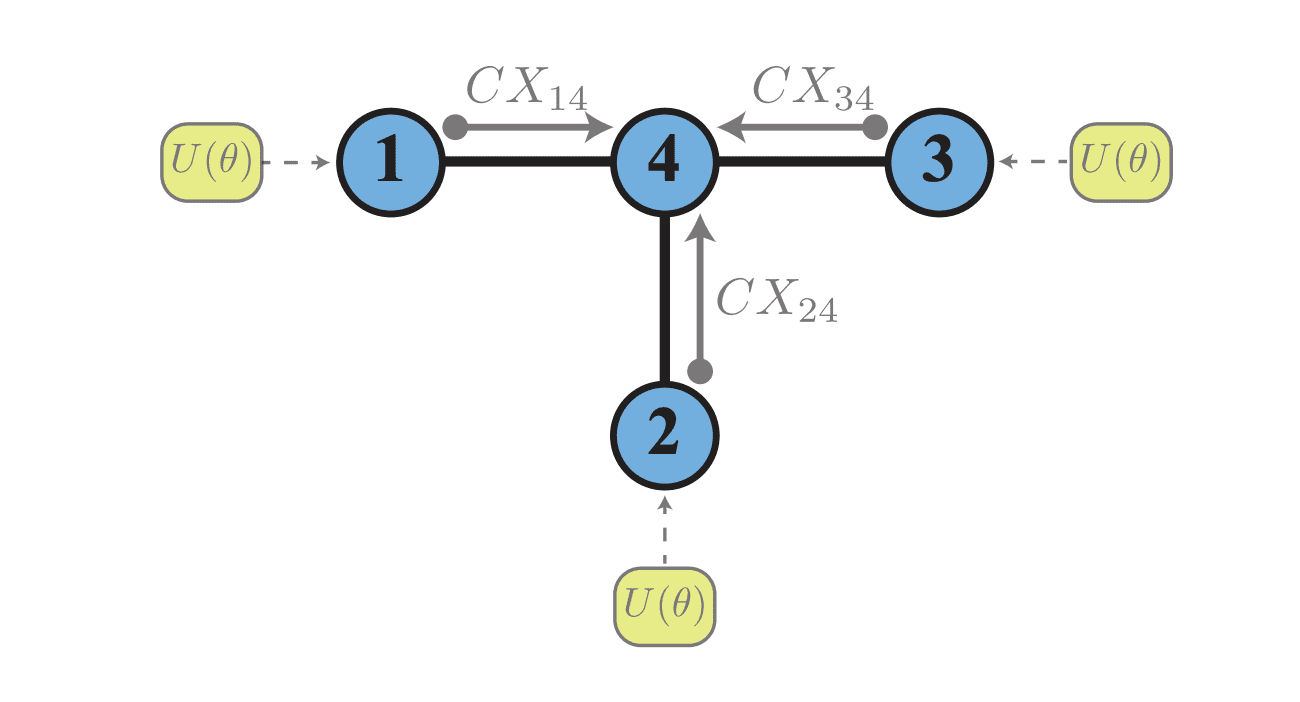The creation of complex, entangled states is central to unlocking the potential of quantum computing, yet generating these states on existing hardware presents significant challenges. Francisco Albarrán-Arriagada, Guillermo Romero, and Juan Carlos Retamal investigate methods for producing equally entangled multiqubit states specifically designed for digital computers with limited qubit connectivity. Their work details protocols for both star and linear configurations, demonstrating that translationally invariant entanglement can be achieved regardless of the number of qubits involved. This research offers a feasible pathway towards experimentally realising symmetric quantum states on near-term devices, bypassing the need for all-to-all qubit connectivity and opening up new possibilities for quantum computation.
A limitation exists in current quantum hardware, motivating an examination of two distinct qubit arrangements: star connectivity, which enables rotationally invariant entanglement, and linear connectivity, which achieves translationally invariant entanglement. The research focuses on demonstrating the scalability of a proposed protocol using a variant of the time-dependent density matrix renormalization group (tDMRG) algorithm, specifically for the linear configuration, and proves its independence from the number of qubits. A slight modification to the protocol reveals the presence of quantum states exhibiting periodicity of entanglement among nearest-neighbor qubits. These configurations and protocols are well-suited for near-term quantum devices, offering a feasible route for exploration.
Entangling Qubits with Controlled Gate Sequences
Researchers have developed a protocol for generating complex, multi-qubit states exhibiting specific symmetries, crucial for advancing quantum computing. This work addresses a significant challenge in the field: creating entangled states on digital computers that often have limited connections between qubits. The team successfully demonstrated the generation of both rotationally and translationally invariant states, tailoring their approach to accommodate the constraints of current hardware. They achieved this by carefully designing sequences of operations applied to qubits arranged in star and linear configurations.
Experiments reveal that the protocol functions independently of the number of qubits used, a remarkable feat achieved through a modified time-dependent density matrix renormalization group (tDMRG) algorithm. This algorithm efficiently manages the computational complexity of simulating many-qubit systems, allowing researchers to explore states with an increasing number of entangled qubits. Notably, the team discovered that specific configurations naturally exhibit periodicity among neighboring qubits, enhancing the symmetry of the generated states. The star configuration, while effective, faces scalability limitations, prompting a focus on the more versatile linear configuration for larger systems.
Further investigations using the DMRG algorithm demonstrate that the linear configuration maintains translational invariance, meaning the entanglement between qubits remains consistent regardless of their position within the chain. Simulations with up to 60 qubits show that neighboring qubits exhibit remarkably consistent levels of entanglement, confirming the robustness of the approach. The data confirms that the entanglement generated is largely unaffected by the number of qubits, a critical advantage for building larger, more powerful quantum computers. This breakthrough delivers a feasible pathway for realizing symmetric states on near-term devices, paving the way for more complex quantum algorithms and applications.
Symmetric Entangled States on Limited Architectures
This work demonstrates protocols for generating multiqubit states exhibiting translational invariance, meaning the entanglement between neighboring qubits remains consistent throughout the system. Researchers explored both star and linear qubit configurations, successfully creating states where entanglement is independent of the number of qubits used. The star configuration allows for the creation of ring configurations through measurement, resulting in equal entanglement between all qubit pairs. These findings offer a feasible pathway towards realizing symmetric entangled states on current digital quantum computers, which often have limited qubit connectivity.
The developed protocols are tailored for these restricted architectures, making the experimental implementation of these states more attainable. While the study acknowledges the limitations of current hardware, it provides a foundation for future exploration of symmetric entangled states and their potential applications. Future research could focus on extending these protocols to more complex qubit arrangements and investigating the properties of these states in greater detail.
